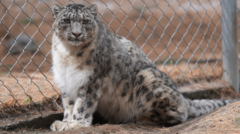Despite ongoing conservation efforts, the unique Gangetic dolphins of India are struggling for survival, facing threats from habitat disruption, fishing practices, and a slow reproductive cycle.
India's Gangetic Dolphins Face Existential Threats as Population Counts Reveal Alarming Trends

India's Gangetic Dolphins Face Existential Threats as Population Counts Reveal Alarming Trends
A new survey spots over 6,300 river dolphins in India, but ongoing human activities jeopardize their fragile existence.
India's iconic rivers, particularly the Ganges, cradle a population of approximately 6,327 dolphins, comprising mainly the endangered Gangetic dolphin, yet these aquatic mammals are battling severe existential challenges. Unlike their ocean-going relatives, the Gangetic dolphins demonstrate distinctive behaviors; they swim sideways and have adapted to murky river environments, relying heavily on echolocation due to their near blindness.
The Wildlife Institute of India's recent survey, the first of its kind in decades, reveals that the inland ecosystems host 6,324 Gangetic dolphins and a mere three Indus dolphins, the latter dwindling mainly across the border in Pakistan. Classified as "endangered" by the International Union for Conservation of Nature (IUCN), both species face a multitude of threats including habitat degradation, accidental entrapment in fishing gear, and deliberate poaching for their oils and meat.
This alarming report highlights the critical need for ongoing monitoring as previous conservation measures have shown only modest success; since the 1980s, over 500 dolphins have perished due to human interference. Conservationist Ravindra Kumar Sinha notes a marked change in awareness about these river dolphins since the Gangetic dolphin was named India's national aquatic animal in 2009.
Although recent initiatives and dedicated action plans have aimed to bolster the dolphin population, illegal killings continue due to fishermen's fears of facing legal penalties. Furthermore, booming river cruise tourism across the Ganges and Brahmaputra intensifies habitat disturbances, further placing these sensitive dolphins at risk.
Historically, the evolutionary adaptations of the Gangetic dolphins position them uniquely. Their limited eyesight and slow swimming abilities contribute to their vulnerability, significantly increasing their chances of dangerous collisions with vessels and other obstacles. The reproductive challenges are equally daunting; females give birth infrequently and have prolonged maturation periods of up to ten years.
Nevertheless, in the face of adversity, some experts like Sinha harbor optimism for the dolphins' future, emphasizing the importance of governmental action in conservation. Despite achievements thus far, the path to safeguarding these elusive creatures remains fraught with challenges, underscoring the urgent need for enhanced conservation strategies and public awareness.






















